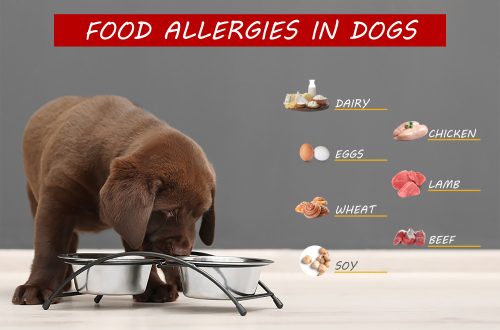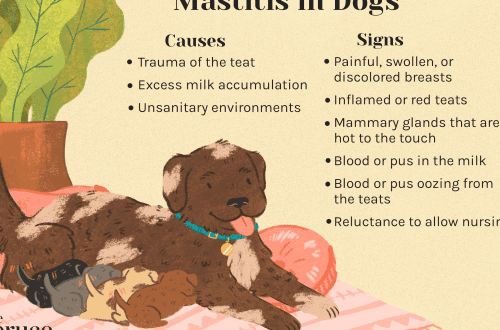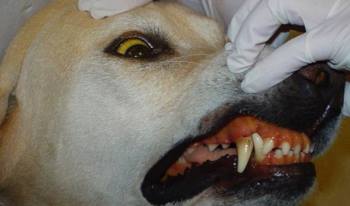
What to do if a dog is bitten by a bee or wasp?
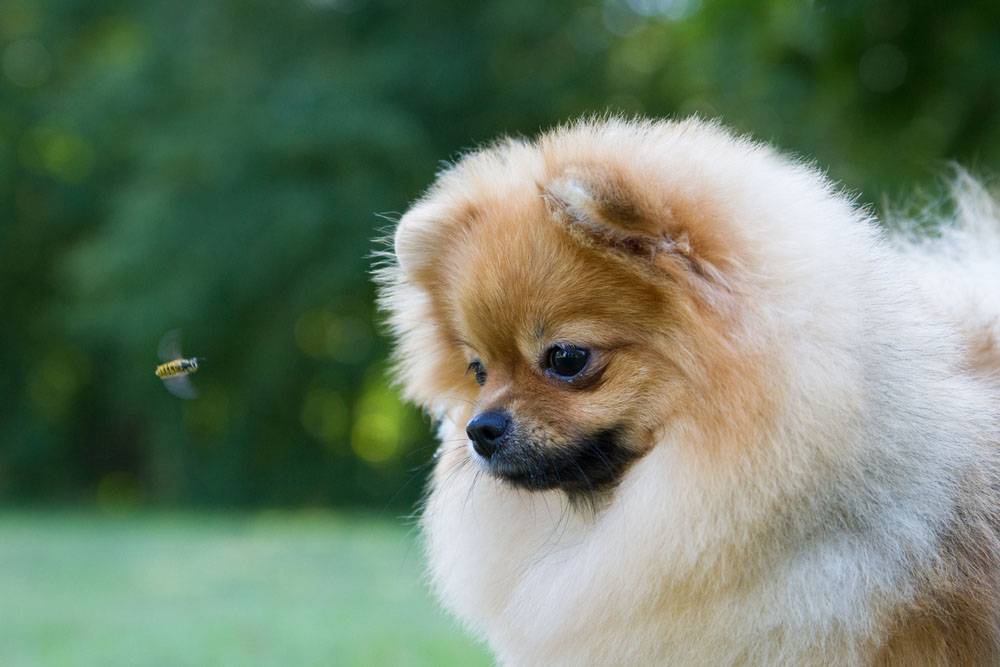
Contents
The danger of a bee or wasp sting for dogs
A huge number of insect bites that cause a reaction in dogs are from members of the Hymenoptera family (hymenoptera): bees, wasps, bumblebees and hornets.
In the process of stinging, the bees leave a sting in the body of the animal, as well as a bag of poison. Therefore, it would be more accurate to say that they sting, not bite. Wasps and hornets have very powerful jaws, they can bite with them, causing severe pain to the dog during the bite.
The venom of these insects contains biologically active substances: histamine, hyaluronidase, melittin, kinins, phospholipase and polyamines.
As a result of the action of histamine, an allergic reaction occurs, edema, blood vessels dilate and blood pressure drops, and bronchospasm appears.
Kinins and hyaluronidase are enzymes that lead to toxic local reactions.
Melittin is a particularly dangerous toxin. It negatively affects metabolic processes, provokes the destruction of red blood cells (erythrocytes), as well as muscle contraction. In addition, it increases the permeability of the walls of blood vessels.
Not everyone knows that after the bees sting someone, these insects die.
Wasps are able to sting many times and simultaneously bite with their jaw, causing sharp pain at the bite site in dogs.
The sting of bumblebees and hornets has no notches, and this allows it to be used repeatedly. The danger of hornets lies in the fact that they can gnaw holes in the fruits they feed on. A live hornet can fall into the dog’s mouth along with the fruit.
If a bee (or other insect) has bitten a dog in the head area, the consequences are more serious.
If the insect stings on the limb, the dog experiences acute local pain, without serious complications.
A threat to the dog’s life is the attack of a whole swarm of bees or wasps at once. If a dog is bitten by a hornet or a bumblebee, then this requires immediate treatment.
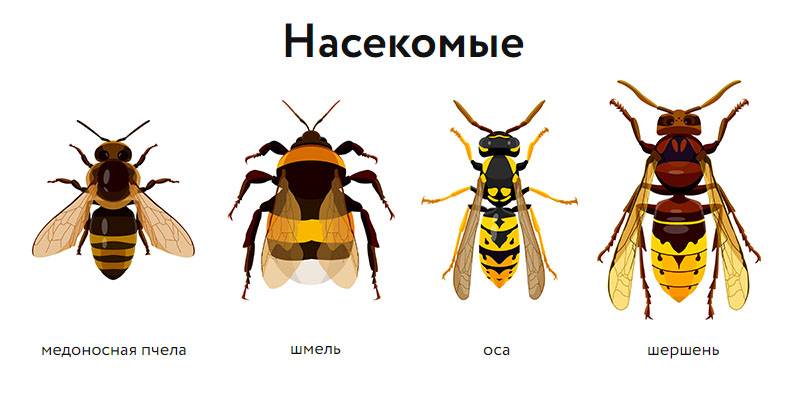
First aid if the dog is bitten by a bee or wasp
Do not panic and waste precious time, but it is better to immediately start providing first aid to your pet!
Consider step by step what the owners need to do if the dog was bitten by a bee, wasp, hornet, bumblebee.
It is recommended to act according to the following algorithm:
Locate the sting and remove the stinger if the sting was a bee sting. This will prevent further entry of the poison into the dog’s body. It is better to do this with tweezers so as not to crush the poison sac. The tool must be pre-treated with an alcohol-containing solution. If you do not have tweezers at hand, try to remove the sting with a sewing needle or pin (be sure to disinfect before use!).
Treat the bite site with an antiseptic solution. It can be hydrogen peroxide, chlorhexidine solution, calendula tincture. Can be washed with a weak solution of potassium permanganate or soap and water.
Do a cold compress. You can apply for 10-15 minutes a cloth dipped in cold clean water. Ice or bags of frozen convenience foods from the refrigerator will do, just wrap them in a towel beforehand. This will help relieve the dog’s pain and prevent the development of severe swelling at the site of a bee or wasp sting.
Apply ointment. To relieve itching and reduce swelling, Fenistil Gel, hydrocortisone ointment 1%, Advantan can be used in the bite area.
Give an antihistamine. If there is one of the following medications in the home medicine cabinet – Zirtek, Cetrin, Suprastin, Tavegil – you can give it to the dog. But it is better to clarify the dosages for the weight of your pet by calling your veterinarian. With local allergic reactions, a tablet form of drugs is sufficient. The course of admission is from 1 to 5 days.
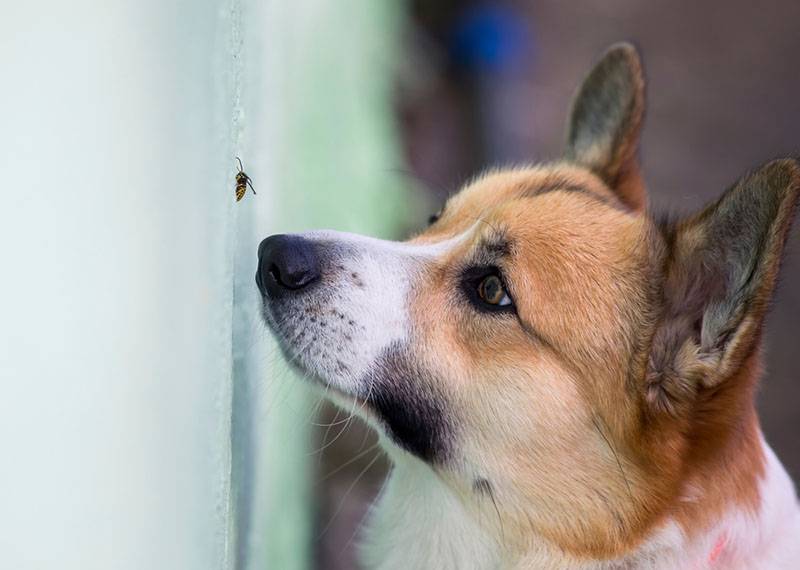
Possible complications
Some pets have a hard time with bee venom (apitoxin), which enters their body if stung by a bee or wasp. The symptoms and behavior of the dog depend on the amount of poison that has entered the body and individual sensitivity.
Allergy
When a dog is bitten by a bee or other insect, local or generalized allergic reactions may occur.
Symptoms of a local allergic reaction:
Swelling and itching at the bite site.
Profuse salivation (salivation).
Lachrymation and clear (serous) discharge from the nose.
Labored breathing.
Sharp pain.
Temperature.
Disorders of the gastrointestinal tract.
Help the animal: If the dog has been bitten by bees or other insects, the algorithm described above should be followed at home. If there is no improvement, you need to go to the nearest veterinary clinic or call a doctor at home.
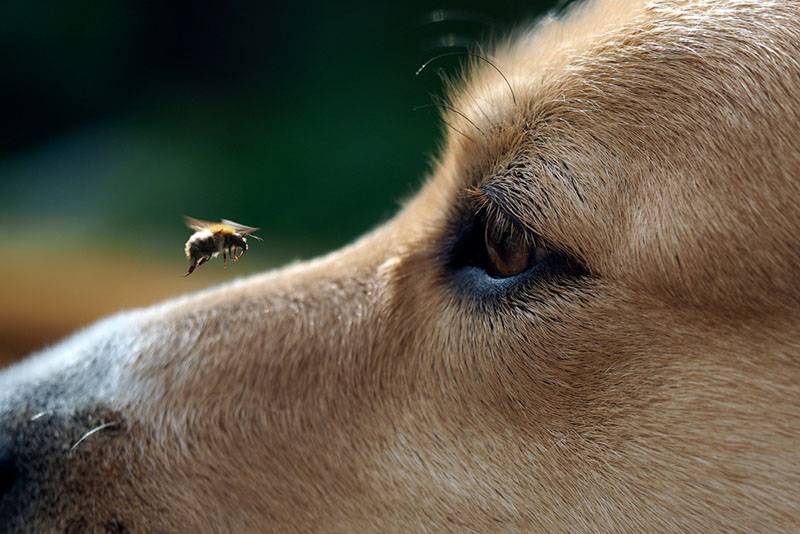
Symptoms of a generalized allergic reaction:
A rash (urticaria) that is best seen in the groin and abdomen, where there is less hair
Choking can occur in case of a bite in the tongue, palate, throat, if the insect has got into the mouth. Severe swelling will lead to respiratory failure
Anaphylactic shock. The speed of manifestation is from several minutes to 5 hours from the moment of contact with the allergen (insect venom). Anxiety, vomiting, diarrhea, shock.
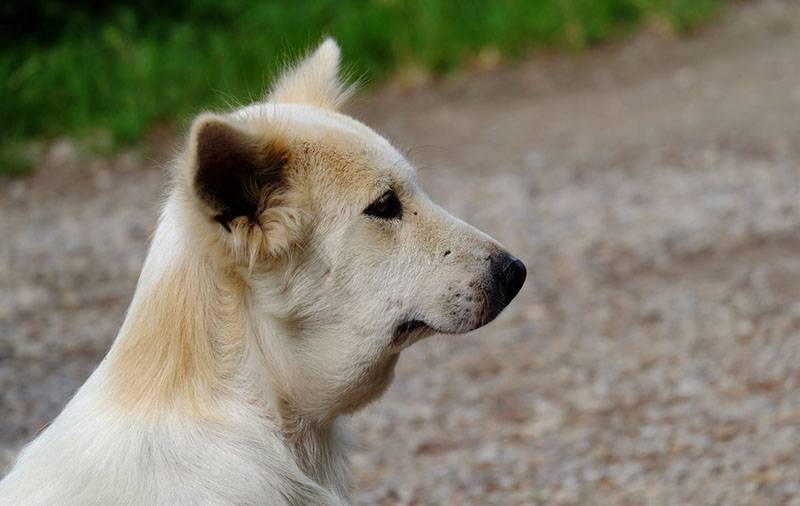
Help the animal: With the manifestation of a generalized form of allergy, immediate assistance is required with the use of injectable forms of drugs. It is advisable to have ampoules of Diphenhydramine, Dexamethasone (or Prednisolone), Adrenaline in the home medicine cabinet in advance in such a case.
The veterinarian operates according to the following treatment scheme:
Lightning shock: 1 ml of epinephrine (Epiniphrine) is mixed with 9 ml of saline (0,9% sterile sodium chloride solution) and administered intravenously at a dosage of 0,1 ml/kg.
Dimedrol (Diphenhydramine) 1 mg/kg intramuscularly or subcutaneously. According to indications 1-2 times a day.
Dexamethasone or Prednisolone (short-acting corticosteroids) 0,1-0,2 mg/kg IV or IM.
When the condition stabilizes, most patients are treated on an outpatient basis. Hospitalization and monitoring are indicated for animals with severe edema and symptoms of hypotension (low blood pressure).
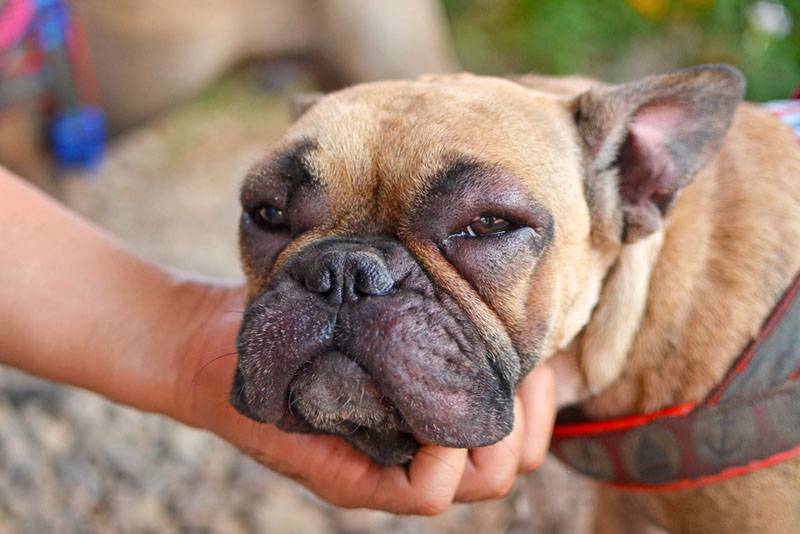
Generalized toxic reaction
It occurs when a large amount of poison is received, when an animal bites a large number of insects at once. It is a life-threatening multi-organ lesion that is often fatal.
Symptoms:
Depression, weakness, fever, hypotension.
Paleness or hyperemia (redness) of the mucous membranes.
Respiratory distress (breathing disorders).
Neurological disorders in the form of ataxia, seizures, paralysis of the facial nerve.
Diarrhea with blood.
Blood coagulation disorders (thrombocytopenia, DIC), petechiae (pinpoint hemorrhages on the skin), bleeding at the site of the intravenous catheter appear.
Arrhythmia.
Help the animal: When a dog has been bitten by a large number of insects, an urgent hospitalization of the patient to the intensive care unit is required, where oxygen inhalation, infusion and anti-shock therapy with monitoring of blood pressure and ECG are immediately prescribed. The prognosis in such cases is from cautious to unfavorable.
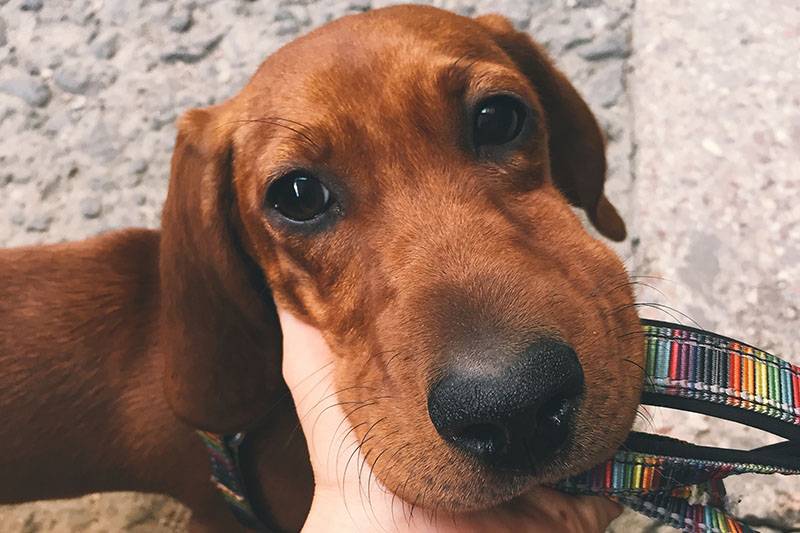
What can not be done?
Try to pull the sting out with your fingers.
Comb the place where the dog was bitten by a bee. But since this is difficult to explain to a pet, it is better to purchase and wear a protective collar for a few days until the itching disappears.
Self-medicate with traditional medicine and waste precious time.
Force feed your dog. It will be enough to provide access to drinking water.
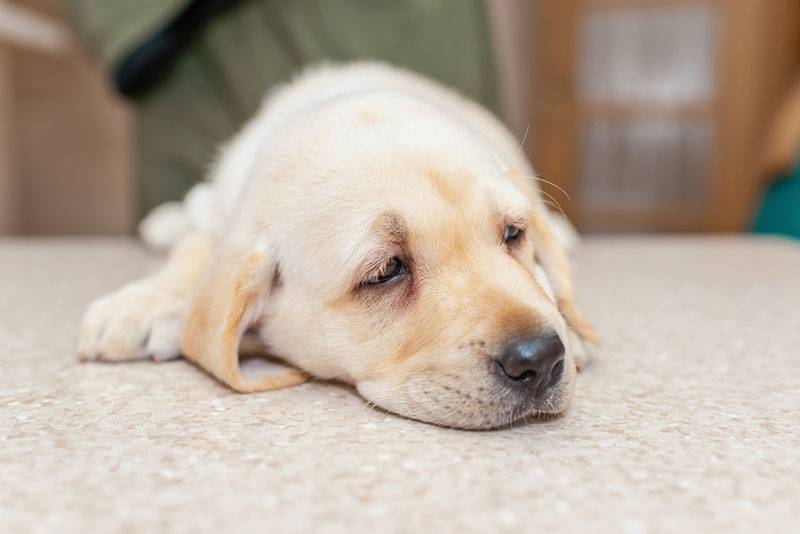
Minimize the risk of contact with stinging insects
If you don’t want a bee to sting your dog, try to avoid walking near the apiary. If you see a hornet’s nest in a tree, immediately move away from this place. Do not feed sweet fruits and vegetables to your pet in the open air, bees, wasps and other insects can flock to the smell and sting the dog.
If the dog was stung by a bee or wasp – the main thing
Determine where the dog was stung by a wasp, bee, or other insect and try to immediately carefully remove the sting (if it was a bee) without damaging the poison sac.
Apply a topical antiseptic, apply a cold compress, and give an antihistamine.
Do not leave a dog that has been bitten by a wasp or other insect unattended, as deterioration may occur after 3-5 hours or more.
With a rapidly increasing swelling, rash, difficulty breathing or fever, an immediate visit to the veterinary clinic is required.
Answers to frequently asked questions
Sources:
D. McIntyre, K. Drobac, W. Saxon, S. Haskinga “Emergency and Small Animal Intensive Care”, 2013
A. A. Stekolnikov, S. V. Starchenkov “Diseases of dogs and cats. Complex diagnostics and therapy”, 2013



